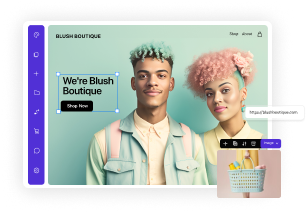Top 10 Types Of Advertising & How To Use Them In 2025
Updated Apr 18, 2025 | Published Apr 8, 2025 | 16 min read

There are many different types of advertising media, from traditional radio and newspapers to online advertising through social media platforms, email campaigns, and videos.
Knowing which types of advertising would work best for you is helpful if you’re running a business. Every advertising strategy has strengths that can help you reach your target audience.
In this guide, we’ll count down the top 10 types of advertising and explain how to use each effectively.
Advertising is paying to promote a product, service, or message to a specific audience. Simply put, you tell potential customers what products or services you sell when you advertise your business.
An effective ad campaign helps you connect with your customers and encourage them to take action, whether visiting a brick-and-mortar store or purchasing online.
These advertising techniques do more than announce a business’s products to the world. They help people understand why they should choose one company over another and build trust in your brand.
Advertising technology has transformed how businesses promote themselves, and reaching target audiences is easier than ever.
When promoting your business, you can use traditional, digital, or both types of advertising. Traditional media includes newspapers, billboards, radio, and TV ads. It’s the kind of marketing we’ve seen for decades, often used to reach a broad audience.
Also known as broadcast advertising, traditional advertising methods can effectively build brand awareness locally or nationally. However, it can be expensive, especially TV ads, which are hard to measure and don’t allow for interaction with your audience.
Digital marketing, or digital advertising, uses the internet to deliver ads through websites, apps, and online platforms. It includes social media ads, SEO for search engines, Google ads, sponsored posts, and email campaigns.
One of the biggest advantages of digital marketing is targeting customers based on their interests, location, behaviour, and more. It also makes it easy to track your results in real time, so you can see what’s working and make quick changes.
For many small businesses, digital advertising offers a flexible and cost-effective way to connect with the right people at the right time.
Read more: Best small business ideas to get you started as an entrepreneur.
Whatever your business type, chances are you will have an advertising strategy. The advertising landscape keeps changing, but some campaign types stand out for their versatility and impact. These include social media campaigns, search engine ads, email marketing, influencer partnerships, and content marketing.
Traditional routes like TV and radio ads, print advertising, and billboard campaigns still matter, especially for local reach. The best advertising techniques mix creativity with strategy, and choosing the right approach depends on your goals, target audience, and budget.
Here are 10 types of advertising campaigns businesses use to get results across different platforms and markets.
Despite the popularity of podcasts and streaming music, many people still listen to the radio. When you place a radio advertisement, you create a short audio message to play between songs or shows on radio stations.
Radio advertising uses voices, music, and sound effects to catch listeners’ attention without using visuals. Local businesses and national brands use radio ads because they can reach many different types of people and are usually reasonably priced.
When using radio advertising:
Direct mail advertising involves sending marketing materials such as postcards, brochures, catalogs, or letters to people’s mailboxes.
Even in the digital world, receiving something real can get people’s attention and make you stand out in a way that emails or online ads sometimes can’t. After all, when was the last time you had anything interesting come by post?
The great thing about direct mail is that you can choose who receives your materials, whether it’s everyone in a specific neighborhood or past customers you’d like to win back. You can also easily track results by including special codes or offers that are only available through the mail piece.
To grab people’s attention, consider:
Outdoor or street advertising includes billboards, bus shelter ads, signs on buses and taxis, and digital screens in public places. It easily catches people’s attention as they spend their day outside their homes.
Unlike online ads that people can skip or ignore, outdoor ads become part of the environment and are seen repeatedly. The repetition helps people remember your business, even if they don’t recall seeing the ad.
Modern digital billboards can even change their message based on the time of day or weather, making outdoor advertising more flexible.
To reach your audience:
Turn your idea into a store: Start selling with Friday.
Print advertising involves placing ads in magazines, newspapers, and local directories. Even with the rise of digital media, many people still enjoy reading print media and spend more focused time reading them than they do online platforms.
Print ads often feel more trustworthy, especially in niche magazines where readers already care about the topic.
For example, a flower business would find an engaged audience in bridal magazines, while a B2B company might advertise in industry publications read by decision-makers.
To make print advertising work for you:
Native advertising is content that looks and feels like regular material on a website, social media platform, or publication, but is a paid promotion.
The secret to native ads is that they blend in with their surroundings. They might be a sponsored article on a news website, a promoted product listing on a shopping site, or a recommended post in your social media feed.
People often find native ads less disruptive than traditional ads because they match what they engage with. While these ads tend to have the label “sponsored” or “promoted” to maintain transparency, they typically receive more attention than banner ads or pop-ups because they provide value through interesting or useful content.
For native advertising:
Display advertising refers to visual ads on websites, apps, and social media. Think of interactive, image, and banner ads designed to catch your eye while browsing online content. Modern display ads are much more targeted and relevant than the random pop-up ads of the early internet.
Today’s display advertising uses data about online behavior and interests to show ads to the people most likely to be interested in them. For instance, if you’ve been looking at hiking gear online, you might later see display ads for outdoor equipment stores.
When utilizing this type of advertising:
Paid search advertising means placing ads that appear when people search on Google or Bing for specific terms. These ads typically appear at the top of search engine results pages, marked as “sponsored” or “ad.”
Unlike most advertising that interrupts something else people are doing, search ads show up exactly when someone is actively looking for information related to your business.
Paid search advertising works on a pay-per-click model (PPC ads), which means you only pay when someone clicks on the ad, which takes them to your website.
This ad type work best when you:
Video advertising uses moving images, sound, and storytelling to promote brand awareness across platforms like YouTube, social media, streaming services, and websites. If you enjoy being on camera, becoming a YouTuber is one way to build trust, grow an audience, and promote your brabd.
Video ads vary in format depending on where they appear. Social media platforms favor short, attention-grabbing videos that work without sound. Streaming services usually show longer ads before, during, or after content, while interactive videos allow viewers to click for more information or purchase directly from the video.
To create effective video ads:
Today, a business is expected to have a social media presence and build a following through engaging social media posts. Social media advertising means placing paid content in people’s feeds on platforms like Instagram, TikTok, Facebook, and LinkedIn.
The power of this form of advertising lies in its precise targeting capabilities. It’s easy to create social media ads yourself without hiring advertising agencies. Even small businesses with a very limited ad spend can reach precisely the right people rather than paying for broad exposure to uninterested audiences.
Social media advertising also benefits from being seen on multiple devices. As most people now shop on their cell phones, it’s important to get your mobile advertising right.
Keep these points in mind:
Integrated multi-channel advertising means marketing across multiple platforms to create full advertising campaigns and a consistent customer experience. Rather than treating each advertising method as separate and unrelated, this approach recognizes that people move between different media outlets daily and respond accordingly.
For example, someone might first notice your billboard while driving, later see your social media ad while browsing their phone, find your website through paid advertising, and finally receive a personalized email convincing them to buy.
Integrated multi-channel works best when you:
Not every type of advertising will suit every business, and that’s okay. The key is to match your brand advertising strategy to your business goals, audience, and personality. Traditional methods like print ads or local radio might work wonders if you’re a local business looking to attract nearby customers.
Digital ads, paid advertising, or mobile advertising can quickly get you in front of the right people. Start by asking, “Who do I want to reach, and where are they spending their time?” The right answer will help you pick the right platform.
If you feel uncomfortable doing your own advertising, there are different marketing and advertising companies that can help you build a campaign.
Traditional and digital advertising have a place in business today and provide multiple ways to advertise products and services.
No matter which types of advertising you choose, remember the basics: know who your customers are, create clear and compelling messages that explain why they should choose your business, maintain a consistent identity across all your advertising, and measure results to improve your approach continuously.
The right mix of strategy and execution will help your advertising do what it’s meant to—get real results.
